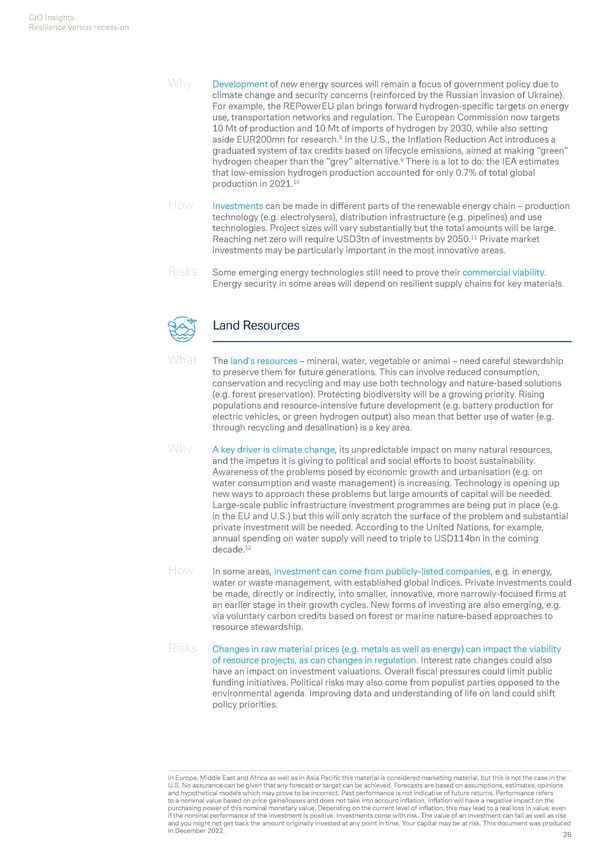CIO Insights Resilience versus recession Why Development of new energy sources will remain a focus of government policy due to climate change and security concerns (reinforced by the Russian invasion of Ukraine). For example, the REPowerEU plan brings forward hydrogen-specific targets on energy use, transportation networks and regulation. The European Commission now targets 10 Mt of production and 10 Mt of imports of hydrogen by 2030, while also setting aside EUR200mn for research.8 In the U.S., the Inflation Reduction Act introduces a graduated system of tax credits based on lifecycle emissions, aimed at making “green” hydrogen cheaper than the “grey” alternative.9 There is a lot to do: the IEA estimates that low-emission hydrogen production accounted for only 0.7% of total global production in 2021.10 How Investments can be made in different parts of the renewable energy chain – production technology (e.g. electrolysers), distribution infrastructure (e.g. pipelines) and use technologies. Project sizes will vary substantially but the total amounts will be large. 11 Reaching net zero will require USD3tn of investments by 2050. Private market investments may be particularly important in the most innovative areas. Risks Some emerging energy technologies still need to prove their commercial viability. Energy security in some areas will depend on resilient supply chains for key materials. Land Resources What The land’s resources – mineral, water, vegetable or animal – need careful stewardship to preserve them for future generations. This can involve reduced consumption, conservation and recycling and may use both technology and nature-based solutions (e.g. forest preservation). Protecting biodiversity will be a growing priority. Rising populations and resource-intensive future development (e.g. battery production for electric vehicles, or green hydrogen output) also mean that better use of water (e.g. through recycling and desalination) is a key area. Why A key driver is climate change, its unpredictable impact on many natural resources, and the impetus it is giving to political and social efforts to boost sustainability. Awareness of the problems posed by economic growth and urbanisation (e.g. on water consumption and waste management) is increasing. Technology is opening up new ways to approach these problems but large amounts of capital will be needed. Large-scale public infrastructure investment programmes are being put in place (e.g. in the EU and U.S.) but this will only scratch the surface of the problem and substantial private investment will be needed. According to the United Nations, for example, annual spending on water supply will need to triple to USD114bn in the coming decade.12 How In some areas, investment can come from publicly-listed companies, e.g. in energy, water or waste management, with established global indices. Private investments could be made, directly or indirectly, into smaller, innovative, more narrowly-focused firms at an earlier stage in their growth cycles. New forms of investing are also emerging, e.g. via voluntary carbon credits based on forest or marine nature-based approaches to resource stewardship. Risks Changes in raw material prices (e.g. metals as well as energy) can impact the viability of resource projects, as can changes in regulation. Interest rate changes could also have an impact on investment valuations. Overall fiscal pressures could limit public funding initiatives. Political risks may also come from populist parties opposed to the environmental agenda. Improving data and understanding of life on land could shift policy priorities. In Europe, Middle East and Africa as well as in Asia Pacific this material is considered marketing material, but this is not the case in the U.S. No assurance can be given that any forecast or target can be achieved. Forecasts are based on assumptions, estimates, opinions and hypothetical models which may prove to be incorrect. Past performance is not indicative of future returns. Performance refers to a nominal value based on price gains/losses and does not take into account inflation. Inflation will have a negative impact on the purchasing power of this nominal monetary value. Depending on the current level of inflation, this may lead to a real loss in value, even if the nominal performance of the investment is positive. Investments come with risk. The value of an investment can fall as well as rise and you might not get back the amount originally invested at any point in time. Your capital may be at risk. This document was produced in December 2022. 28
 Deutsche Bank Economic and Investment Outlook Page 29 Page 31
Deutsche Bank Economic and Investment Outlook Page 29 Page 31